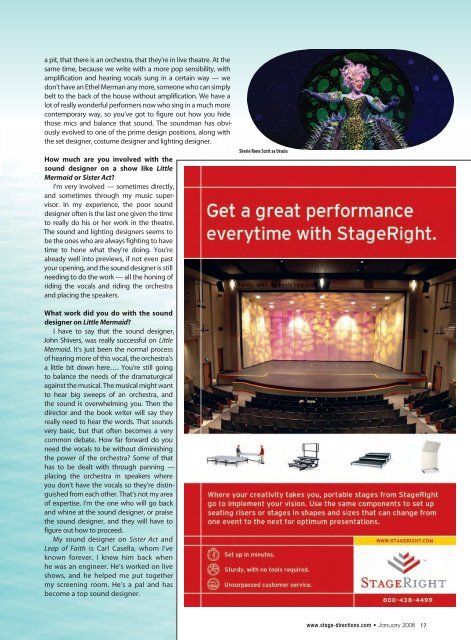Download a PDF - Stage Directions Magazine
Download a PDF - Stage Directions Magazine
Download a PDF - Stage Directions Magazine
You also want an ePaper? Increase the reach of your titles
YUMPU automatically turns print PDFs into web optimized ePapers that Google loves.
a pit, that there is an orchestra, that they’re in live theatre. At the<br />
same time, because we write with a more pop sensibility, with<br />
amplification and hearing vocals sung in a certain way — we<br />
don’t have an Ethel Merman any more, someone who can simply<br />
belt to the back of the house without amplification. We have a<br />
lot of really wonderful performers now who sing in a much more<br />
contemporary way, so you’ve got to figure out how you hide<br />
those mics and balance that sound. The soundman has obviously<br />
evolved to one of the prime design positions, along with<br />
the set designer, costume designer and lighting designer.<br />
How much are you involved with the<br />
sound designer on a show like Little<br />
Mermaid or Sister Act?<br />
I’m very involved — sometimes directly,<br />
and sometimes through my music supervisor.<br />
In my experience, the poor sound<br />
designer often is the last one given the time<br />
to really do his or her work in the theatre.<br />
The sound and lighting designers seems to<br />
be the ones who are always fighting to have<br />
time to hone what they’re doing. You’re<br />
already well into previews, if not even past<br />
your opening, and the sound designer is still<br />
needing to do the work — all the honing of<br />
riding the vocals and riding the orchestra<br />
and placing the speakers.<br />
Sherie Rene Scott as Ursula<br />
What work did you do with the sound<br />
designer on Little Mermaid?<br />
I have to say that the sound designer,<br />
John Shivers, was really successful on Little<br />
Mermaid. It’s just been the normal process<br />
of hearing more of this vocal, the orchestra’s<br />
a little bit down here…. You’re still going<br />
to balance the needs of the dramaturgical<br />
against the musical. The musical might want<br />
to hear big sweeps of an orchestra, and<br />
the sound is overwhelming you. Then the<br />
director and the book writer will say they<br />
really need to hear the words. That sounds<br />
very basic, but that often becomes a very<br />
common debate. How far forward do you<br />
need the vocals to be without diminishing<br />
the power of the orchestra? Some of that<br />
has to be dealt with through panning —<br />
placing the orchestra in speakers where<br />
you don’t have the vocals so they’re distinguished<br />
from each other. That’s not my area<br />
of expertise. I’m the one who will go back<br />
and whine at the sound designer, or praise<br />
the sound designer, and they will have to<br />
figure out how to proceed.<br />
My sound designer on Sister Act and<br />
Leap of Faith is Carl Casella, whom I’ve<br />
known forever. I knew him back when<br />
he was an engineer. He’s worked on live<br />
shows, and he helped me put together<br />
my screening room. He’s a pal and has<br />
become a top sound designer.<br />
www.stage-directions.com • January 2008 17

















